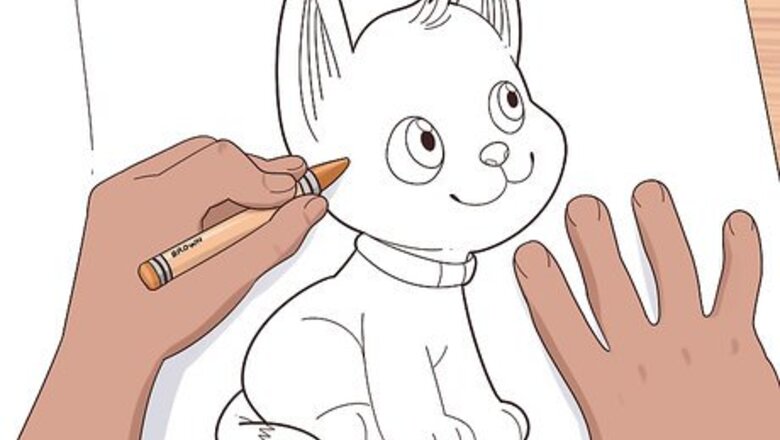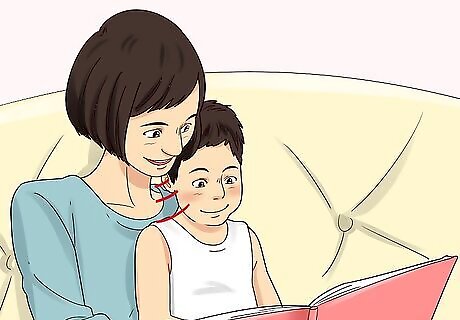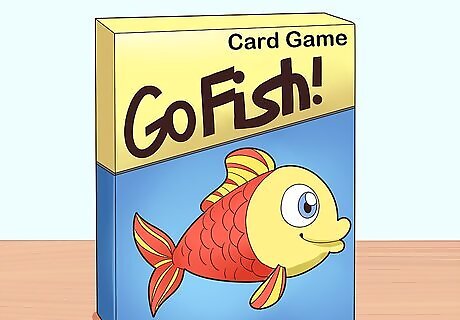
views
Entertaining with Art

Give younger kids a coloring book. Coloring books are a great low-energy activity for little kids. Just give them a book and some crayons, markers, or colored pencils. You don't have to buy coloring books from a store. Search online for free coloring book pages that you can print out. If you don't have a home computer or printer, find out if your local library has any available for use. There isn't an age limit for coloring books, but most children lose interest by the end of elementary school. Offer to color with older children to get them interested in the project. You can engage with a child who is coloring by asking questions. For children from ages 3 through 5, try asking the names of the colors being used. You can also ask about the picture being colored: "What/Who is that?" “What if we color this lighter or darker?” “Should we blend colors?” Be sure to provide only water soluble, non-toxic coloring utensils. Avoid markers and pens when using commercial coloring books. Many coloring books are printed on a type of paper that markers can bleed through, ruining the picture on the next page.

Encourage kids to draw. People of all ages love to draw. Give the kids some printer paper or a sketch book and some drawing utensils. Toddlers can enjoy "drawing" with scribbles. Encourage them to develop their creativity and motor skills. While a child is drawing, ask about the picture being made. Don't directly ask what the drawing is "supposed" to be, since this may discourage a child. Instead, ask the child to tell you about what he or she is drawing. Older kids may not like being asked so many questions. Save them for when the child shows you a finished drawing. You can provide a drawing prompt for older children or ask them to illustrate a story.

Find craft projects to do online or in books. There are thousands of different activities children of all ages can enjoy. Check out websites and blogs run by parents and teachers for ideas. These can be time-honored traditions or completely unique projects. Some examples are: Paper crafts like snowflakes Making pet rocks Fingerpaints Store-bought crafts like models and jewelry kits
Enjoying Stories

Read aloud to young kids. Until kids learn how to read on their own, it's best to sit down and read to them out loud. You may want to record yourself as you read aloud so you can listen to yourself and make adjustments as needed. Practice holding the book in one hand while it faces the children so they can see the text and illustrations. Rhyming books, poems, and songs are great options to read aloud. Select bright, colorful picture books that don't have a lot of text. The younger the child, the slower you should go. Speak clearly and slowly, pausing at each page. Consider letting the child decide when it's time to turn to the next page. Older kids can still enjoy being read to if it's a more complicated story, especially before going to sleep. Reading to kids early and often stimulates their brains and helps them learn verbal skills.

Read with elementary school-aged kids. Once kids start learning how to read, usually at five or six, encourage them to take a more active role. Keep reading the entire story to a child who is just learning how to identify simple words. However, before turning the page, try pointing to a word or two and ask if the child can read the word. Stick to easy words like "red" and "dog" at first. Once a child learns how to read simple sentences, encourage him or her to read picture books to you. If he or she gets stuck on a difficult word, encourage the child to sound it out. If that doesn't work, gently tell the child how to say the word.

Help older kids to read on their own. As their reading skills improve, you don't always have to entertain kids by reading to them directly. Instead, encourage independence by asking them to read to themselves. You can sit next to them and read your own book to model the behavior. As an adult, it's your job to make sure they have what they need. Stock up on age-appropriate books and keep them where the kids can always grab one to read. Take the kids on a trip to bookstores and/or libraries and let them pick out their own books. Participate in local community reading events and book clubs for kids. If you can't find a children's reading program in your area, you can try starting one yourself. You may even be able to apply for grants to help fund these activities. Give older kids access to a dictionary to use when they come across unknown words. If you're a babysitter, bring in a few new books to keep the kids interested. Whatever you bring along will be new and exciting and special.

Encourage kids to make up their own stories. Reading and listening to stories is fun, but making up your own can be just as entertaining, especially for young kids. Ask the kids to tell you a story. You can teach them how to tell a story by telling a simple story first. Then ask for a story from them. Provide support while the children are telling their stories and prompt them with questions like, “What happened first?” “What happened next?” and “What happened last?” If you're entertaining a few kids, try playing a game where everyone tells the story. Go in a circle and take turns, adding on to what the last person said. If one kid tends to hog the spotlight, try adding a rule to limit each turn to one minute or one sentence to include everyone equally. Once kids start to learn how to read and write, they can begin writing down simple stories. Give them paper or a notebook to write in. Older kids may begin to write their own novel-length stories. At this stage, it may be a good idea to let them use a computer to type their stories rather than handwrite them.
Playing Games

Play sports and other outdoor activities. If you're entertaining high-energy kids, they are likely to favor more intense activities like sports. If you don't have a big yard, take a field trip to a local playground or park. Keep the kids busy, active, and well-socialized by signing them up for an organized sports team. When stuck indoors, you can get energy out with dancing to fun music. If you're entertaining a group of kids, you can suggest a game of tag or hide-and-go-seek. You can join in on a game of tag, but don't play hide-and-go-seek unless other responsible adults are present. You shouldn't let kids out of your sight, and if it's your turn to be "it" you would have to. Instead, you can be the game's "referee" to make sure everyone plays fair. Take kids on hiking trips and nature trails. Spending the weekend camping (even if it's just in your own backyard) is also a great option. Cool down during the summer at your local public pool. All kids, regardless of energy level, should get some exercise and time outdoors to stay healthy. Children and adolescents should generally get at least an hour of physical activity each day.

Have a few board games and/or a deck of cards on hand. A classic part of childhood, board games help entertain kids while teaching them valuable life-skills like taking turns. Simple card games like Go Fish are easy to teach to even very young children. Make up your own card game. Assign an activity to each suit, like hearts are jumping jacks and diamonds are making a funny face. Whatever card is drawn, everyone will do that activity for the number of times on the card. Get creative and let the kids decide what activity each suit will be. You or the kids may want to set "house rules" on certain games that may not be in the rule book. While this may be fun for most children, it may be frustrating for others. Make sure the games are age-appropriate. A 10-year-old is likely to get bored with Candyland, while Risk would probably frustrate a kindergartener. If you can't afford to buy board games, your local library may have some available to check out. If you borrow board games, make sure the kids treat them well and avoid losing pieces.

Play video games with your kids but enforce limits. While video games often have a bad reputation among parents, they are a great way to entertain kids when played in moderation. Join in on multiplayer games. Keep the kids active on rainy days with video games that have a physical component. Make sure to pay attention to game ratings and content warnings. Video games are just like movies; they're not all kid-friendly. It's generally best to stick to E-rated games, especially ones specifically made for children. Studies have shown that playing up to 1 hour of video games per day is beneficial to children. However, there can be some negative effects when daily game time climbs to over 3 hours.


















Comments
0 comment